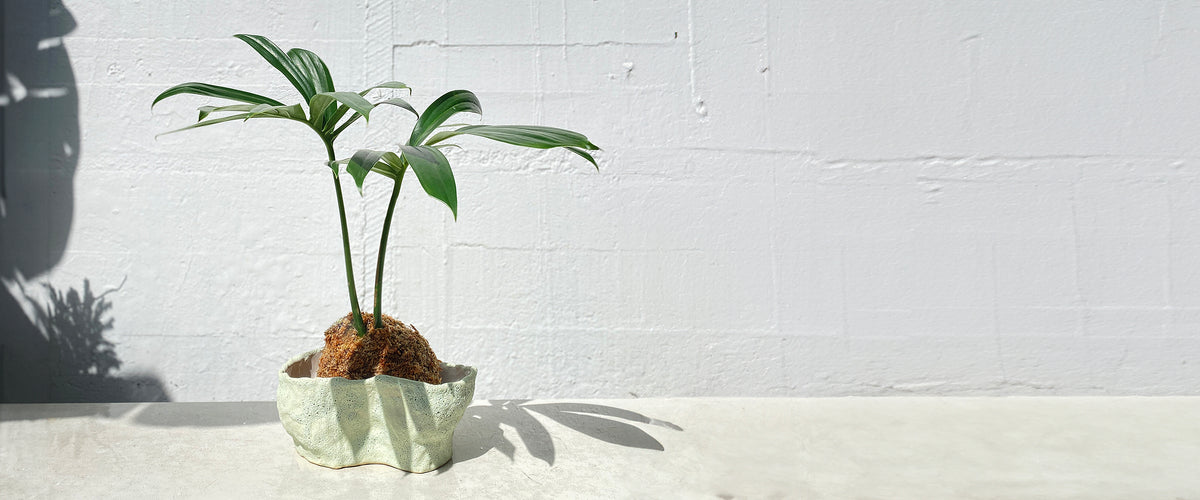Orchid Obsession

We love orchids. They make great gifts, have long lasting flowers, & live for decades with the right care. Plus, they're so pretty! Especially in a kokedama.
Of course, as with any plant, they come with specific needs for them to live their best life. So, we've written this comprehensive guide to make sure you see your orchid's beautiful blooms every year.
The History of Orchids
Orchids have thousands of different species across the world (28,000 to be more exact), making the Orchid genus the largest flowering plant family on earth! This makes a lot of sense when you learn how much time they had to expand the family. A fossilized extinct bee from around 80 million years ago was recently discovered still wearing the pollen of an ancient orchid species!

Aside from being very pretty, almost all orchids are edible to some degree, with some cultures using them as herbal medicine. One orchid that we eat very often is called Vanilla planifolia, which I'm sure you've guessed is the plant that gives us vanilla bean to flavour our baking with.

Our lovely country has been busy making orchid species too! We have over 100 different species of native Orchid spread across Aotearoa, from tiny Bulbophyllum Pygmaeum to our Raupeka, or Easter Orchid.

Raupeka Orchid
The most common, more commercially available orchid species you'll probably recognise are Phalaeonopsis, Dendrobium & Cymbidium, especially Phalaeonopsis which you see everywhere & are very easy to come by.
General Care
The most important thing to remember when caring for your orchid (& most indoor plants), is to try to emulate it's natural environment. In the wild, Phalaeonopsis orchids cling to the textured bark of a tree using their roots, collecting nutrients from leaf debris & other organic matter. They absorb moisture from the humid air & rain, so essentially the roots are kept moderately moist at all times.
Place your orchid somewhere with bright but indirect sunlight (I have my Phalaenopsis sitting away from a north facing window that gets morning sun). Different orchids have different light requirements, but most commercially available species will be happy with bright indirect lighting. This position will also give you a better chance for flowers!

Repotting
Orchids looooove to be rootbound. Which makes repotting something you don't have to think about very often! Generally, orchids can last about two years without needing repotting. You'll be able to see when they need it, as the roots will be pushing up & out of the pot. If you have a clear plastic pot, you'll see that the roots inside will be stacked tightly on top of each other.

A rootbound orchid.
When it does come time to repot, be sure to remember this: never pot an orchid into regular soil. It will die. & we don't want that. Orchids need lots of room between their roots & the potting medium (remember their natural habitat), so something chunky is very important. The tried & true medium is orchid bark, but you can also use sphagnum moss, leca, or a mixture of bark, pumice & peat, with bark making up the majority.
Only pot into a slightly larger pot, giving your orchid just a little more room to grow. Ideally you want to pot your orchid into one of these three containers:
Clear Plastic- An inexpensive option, & will allow you to keep a keen eye on your roots.
Terracotta- Also inexpensive, & replicates that textured surface that orchids enjoy. Also prevents the potting medium from staying wet with it's moisture wicking ability.
Specialised Orchid Pot- These are usually ceramic pots with small holes around the whole circumference. This allows great air flow to keep the roots happy. Our Artist orchid pot is a great option for this, ideally with some drainage added at the bottom.
One last thing about repotting- Repotting when your orchid is flowering can sometimes cause your orchid to drop its flowers. In saying this, a lot of orchids can come potted with a their nursery plug still attached, making root rot very possible, or they might already have root rot! In this case, a rescue mission needs to happen, even if the orchid is blooming.
Root Rot
Root rot usually happens when a plant is overwatered, or has poor soil that doesn't drain well. The roots become brown & mushy (& smelly) as they die, & no longer function as they should, providing the plant with nutrients & hydration.

If you discover your orchid has root rot, it's important to act fast, as it will only spread. Cut all the affected roots off, back to healthy roots, with a pair of clean scissors or a knife, treat the roots you have left with hydrogen peroxide, & pot into fresh potting medium. You may have to downsize your pot to accomodate the lack of roots, & to make sure your orchid can keep up with the moisture levels.
Reblooming
When buying your orchid, try to find the one with the most unopened blooms. This will mean you (or whoever you buy it for) will get to enjoy 2-3 months of gorgeous orchid flowers!
After you've enjoyed the life cycle of your orchid's first bloom, you'll notice the flowers begin to shrivel & drop off. Your plant is not dying, I promise. It's just finished flowering! If you'd like to try to get your orchid to bloom a second time, trim the flower spike to just below the last flower. If you'd like to be patient & let your plant focus on its roots & leaves, cut to just above the last node of the flower stem.

Hopefully this sets you on the right track to a blooming orchid. Remember, with the right TLC, your orchid can live for years & years, blessing you with many more blooms.
Good luck!
